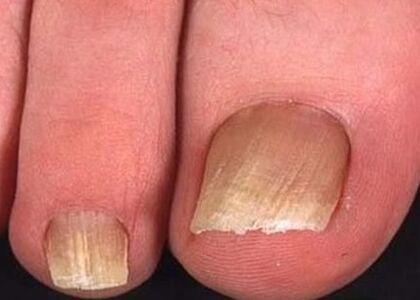
A healthy nail should look good - to be smooth and even.Its color should be beige or slightly pink, which is due to the presence of blood vessels under it.When defects appear, the nail may lose normal color, it becomes dark or painted in a different color.When the thickness changes, the nails become blurry and look sloppy.In some diseases, nail plates can be deformed until their disappearance.
Development malformations can be congenital and acquired.In the first case, this is due to damage to the preduexor Ectoderm-Fabric of nails.It seems like deformation of the nail or absence immediately after the birth of a baby.
Vice obtained can be developed for various reasons.The most common problem is a fungus, which in one form or another is present in any third person.The fungus can be not only the outer, in which only the tiles are affected, but also by the inner ones - the finger fabric can be affected with their later destruction.
In addition, such diseases can lead to step step deformity:
- Psoriasis - with this pathology, the thickness of the nail changes.It becomes denser than usual and unpleasant to touch.In addition, the pain develops - in palpation, felt discomfort.Multi -colored dots develop under the plate - from red to purple - this indicates a hemorrhage.When the infection is joined, the hematoma soup under the nail may be observed.Local detachments from the skin can be observed - the shape of the cavities in these places that give their hands a vague appearance.Further development of the disease can lead to onikolysis.
- Eczema is often accompanied not only by local loss but also by generalized.This means, in addition to damage to the tiles, skin symptoms can also be observed.Eczema is manifested by changes in the nail roller and plates directly.Finger fabrics become swollen, peel can develop.The affected surface scratches and hurts.At the same time, the nail becomes dull and pale, its stratification or fragility is possible.
In addition to these reasons, deformation can be provoked by a fungal infection of the nail plate.
Fungi are a disease that, with a careless attitude, can lead to complete destruction of the plate.In the initial stage, this is manifested only by a change of color and thickening, in the end, the loss leads to the loss of the nail plate.
Signs of infection with a fungus
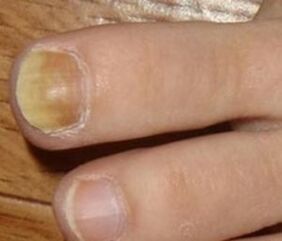
When infection with onychomycosis, there is no sharp intense pain and disability - therefore, people often prefer not to notice it.Moreover, the fungi in its early stage are not manifested by changes expressed in the nail plate and it is difficult to distinguish.
First of all, itching of the skin of the legs appears.Is intense and can be distracted by work or rest.It is caused by the spread of microorganisms in the dermis, which is perceived by the body as irritation.With constant itching, a person may be disturbed by sleep and appetite.When combing the skin, it is likely to bring the bacteria to the micrococks, then the annexation of a secondary infection will develop.
If no treatment measures are taken, then organic changes in the nail and tissues occur.The tile becomes muddy and dark, stains and stripes develop on it, which can be light and dark - it depends on the pathogen.
A change in shade indicates that yeast fungus completely catches the tissue of the plate.Often the color becomes yellow, but brown and white can also occur.
The brightness and fragility of the nails also indicates the fungal process.At the same time, the nails are separated, become unstable.Because of this, painful ingrowths or nail melting can occur from its bed in the event of an injury.
If all these symptoms appear or at least one of them, you should consult a doctor about treatment - without this, the disease can go to a chronic form.
Stages of development of infection
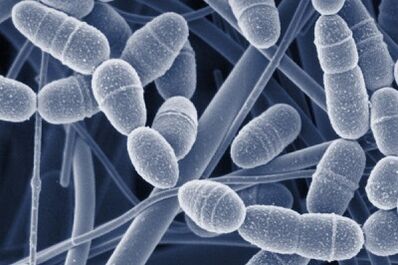
Unlike many pathology, nail fungi are a slowly developing disease.It is characterized by a gradual flow that is difficult to lose.Mushroom therapy is effective at an early stage, so the earlier the help is given, the better.
The initial phase often does not manifest visually.Therefore, it is impossible to show what the nail fungus looks like in the picture on the initial scene.But the first symptoms already appear at this time.A disturbed bell about fungi is strong itching of the skin, which intensifies throughout the day and reaches greater intensity at night.The only sign that can be subject to the idea of a fungus infection is the appearance of a pathological nail color-this is manifested by the development of stains and lines from pale yellow to a white shade.There may be dark areas.
The stage of the normotrophic lesion is manifested by moderate symptoms.This is evidenced by the fact that the nail is not yet thickened and the pronounced deformation is not observed in it.However, stains and stripes become extremely distinct and visible to others.In addition, an unpleasant odor coming from the legs joins.If you do not start treatment, the disease will inevitably go to the last stage.
With hypertrophic lesions, there is a thickening not only of the plaque itself but also the surrounding tissue.This is manifested by nail deformity, can change the direction of growth, crumble and break down from a slight effect on it.As a result, the nail can be reduced, in its place in a severe course of the disease, the new plaque does not grow.
In the presence of simultaneous pathology, the transition from the first phase to the beginning occurs extremely quickly, in just a few weeks.This can be due to the presence of immunity, cancer and body weakness, which develops in old age.
Injection in adults also provoke the development of the disease.This can be a direct damage to the nail as well as the surrounding tissue, when, due to the inadequacy of blood circulation, nail metabolism changes.At this time, ideal conditions for a fungus are created.
With overweight and diabetes mellitus, the nail fungus develops in 95 cases from 100. This is due to the fact that fungal microorganisms get very necessary for the growth and reproduction of substances - for example, glucose and lipids.Therefore, in such patients, pathology is extremely difficult.
Nail fungus when infected with dermatophytes
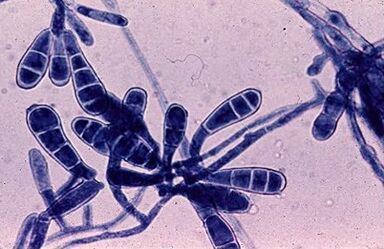
Dermatophytes are the most common cause of pathology.Their infection is quite simple - through ordinary towels, showers or even interior slippers.
This type of fungus has two dangerous representatives who can evenly cause fungal lesions - this is Trichophyton rubrum and trichophyton mentagophytes.
The first representative begins to penetrate under the nail plate from its free edge as it moves further.Signs of infection with this fungus - a change in the color of the nails in pink to the yellow with black cross, the texture of the plate worsens - it becomes fragile and fragile, crushed with physical exposure.
For accurate diagnosis, you need to know what the nail fungus looks like.The most characteristic feature is the appearance of a nail detachment near its side edge.In this space, the accumulation of dirt occurs, which is conducive to the development of microorganisms.During this period, it is still possible to get rid of the fungus without nail loss, simply using ointments and lotions in parallel with antifungal pills.
There is such a distal form of the disease, which is manifested by the onset of the lesion on the nail bed.This form is much less common, as to penetrate there, microorganism is needed for the entrance gate - a microcock or other damage.This situation is not uncommon after an injury.With this option, it is necessary to completely remove the nail plate, as any conservative treatment will be ineffective.
If the cause of the fungus is Trichophyton Mentagophytes, then the signs of the disease will be as follows:
- Obesity - there will be significant hypertrophy of plaque with the presence of deformities and fabric defects;
- The color of the tile becomes intensely yellow, with a tinge of honey;
- An abscess appears on a finger near the nail;
- In the late stage, the skin lesion also joins - in interdigital gaps, peel and skin cracking;
- The appearance of ribbons and white dots develops - these are the places where the fungus parasites more intensely;
- In question, this type of pathogen never parasitizes.
To get rid of this fungus, it is necessary to undergo accurate comprehensive treatment with oral medicines and local remedies - gel and ointments.
In severe cases, you may need to remove nail and laser cleaning to remove microorganisms.This method has many positive comments.It is forbidden to use spray.
Changes in the nail when infected with a gender fungus
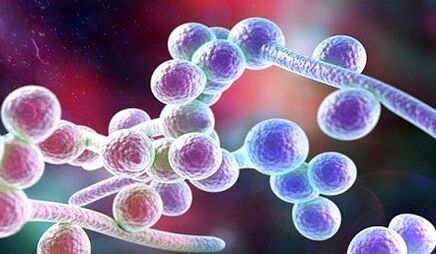
This disease is characterized by damage not only to the limbs but also for the localization in the brush.The main hand is most often affected, for example, the right hand is the right hand.From frequent contact with water, the disease progresses faster.
A characteristic feature of this disease is the nail damage from the box.Over time, more tissues are captured - first the cell division area, and then the free edge.
With this disease, more often than the rest, a secondary infection occurs.Candidiasis is associated with pain in the roller and bed, in palpation it is possible to secrete a serous or purulent discharge.
The nail is gradually deformed and rises above the skin, its thickness can reach a few millimeters.At the same time, the nail is wireless, which is manifested by the presence of so -called scaffolding that can go in different directions.However, with candidiasis, the most common form of nail damage is precisely horizontal stimulation.
In severe pathology, the nail is gradually separated from the nail bed, this is accompanied by discomfort and pain.In the event of the accidental trauma of such a nail, it is possible, accompanied by considerable bleeding.The surface of the wound in this case is delayed for a long time.
If the fungus affects the free edge of the nail, then this is often combined with a generalized skin or shape.Is called distal.This variant of the course of the disease passes more and is more difficult to treat.The distal form indicates that human immunity is weakened and affected by microorganisms.
Candidate treatment varies in different forms and stages of the disease.At first, you can try to influence microorganism with the help of local tools, but with a generalized or progressive form, you should take systemic oral medication.Moreover, if there are signs of extensive fungal damage, it is necessary to prescribe a thorough medical examination for the search for diseases that have reduced immunity levels.
Changes in nail with mold damage
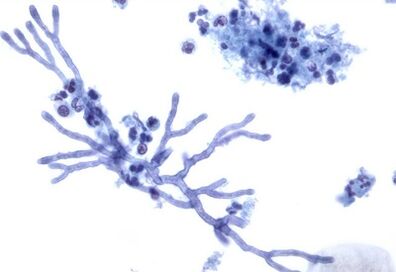
Loss with mold fungi is less common than the rest of the pathogens.This is due to the fact that a person is not so often in contact with this type of microorganism because of their specificity.Most often, these mushrooms are infected against the backdrop of an existing lesion.The favorite colony with which the mold joins is Trichophyton Mentagophytes.Despite this background, you can often see the combined effects of fungi and bacteria.
This disease is characteristic of older people.In this period, there is a decrease in cellular immunity and weakening the body, due to which fungi develop more intensely.
A characteristic feature of these pathogens is their selectivity.They do not affect the skin and soft tissue, located exclusively on the nails.
Among the causative agents, most are mostly found:
- Alternaria - this fungus determines the development of nail deformity and hyperkeratosis.To recover from this disease, it is necessary to remove the nail plate, as the microorganisms are extremely deep in the tissue and it is quite difficult to eliminate them.
- Skytalidium dimidiatum - most often such microorganisms appear in patients with diabetes.To get rid of such a fungus, it is necessary to carefully monitor the blood glucose level and observe the endocrinologist in parallel.
- Scopulariopsis brevacaulis is most often found in public places, for example, in baths, pools, showers.When located on the nail plates, there is a difference in their color from pink to white.
- Fusarium is common in rural areas, is very much on the ground, from which it can easily pass on the fabric.This fungus, when penetrating the body, can cause mycosis of the internal organs, which is very difficult to treat.Therapy for such a terrible disease should only be performed in the hospital, as treatment is quite serious for the patient.
Mold damage therapy is very complex, as it is necessary to treat the body by several colonies of microorganisms.To produce high quality therapy, a combination of antibiotics and antifungal drugs is used.In severe cases, they are not administered orally, but intravenously.















